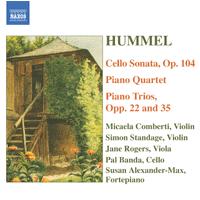
Satisfying Breadth
Chamber music by Hummel,
appreciated by
PATRIC STANDFORD
Naxos 8.557694
|

|
It was in no way the fault of Johann Nepomuk Hummel that, when he died at the relatively early age of 58 in 1837, both his music and his style of keyboard playing were unfashionable. His death was recognised at the time as the end of an era, appreciated but no longer relevant in a musical Europe that had already heard Berlioz's Fantastic Symphony, both Chopin's piano concerti, Donizetti's Lucia di Lammermoor -- his 15th opera, and was about to hear Wagner's Rienzi. But Hummel's career had been startling by any standards of his time, and in the 1820s it was said that no visit to Weimar was complete without seeing Goethe and hearing Hummel improvise. His works, covering all genre but the symphony, include some eighteen operas and six ballets, several concertos mostly for piano, but one for trumpet and another for mandolin, and a fair amount of rather unwilling church music.
This Naxos disc of his chamber music adds a welcome fifth to their series devoted to his versatile talents. It contains two major pieces that should not suffer neglect. The Cello Sonata, written in 1824, shows, as does much of his music from about 1810 onwards, a marked maturity and an exciting integration of its instrumental resources, in this case giving satisfying breadth to his melodic thinking. He was not always comfortable with the development of his ideas (perhaps a reason for his evading the symphony, especially so close to Beethoven) yet the closing section of this sonata's development is a fine piece of work that also demonstrates his skilful keyboard technique
[listen -- track 6, 5:12-6:53].
The posthumously published Piano Quartet sounds to belong to this latter part of his working life too; there are just two movements, an Andante cantabile, and a spirited Allegro -- another work that should not be neglected
[listen -- track 2, 6:20-7:45].
In both those works, Susan Alexander-Max plays a fortepiano reproduction of an 1814 Nanette Streicher, which sounds much better than the 1795 Rosenberger reproduction used in the two earlier Piano Trios, one (Op 22) dated in manuscript 3 March 1799, a rather routine Haydnesque piece, and the other Op 35, published in Vienna in 1811, just as slight in stature but a little more solid in content
[listen -- track 3, 0:00-1:26].
Hummel does not deserve the disdainful neglect that so many historians allocate to him. He had a huge influence on keyboard composers of the next generation and yet it is difficult to find even a passing mention of him in 19th century biography. I suspect it was his rough Viennese accent and colloquialisms that repelled many of the pretentious cognoscenti that would frequent the concert rooms. But no one could deny his astonishing virtuosity, unequalled at the time.
Copyright © 26 August 2006
Patric Standford, Wakefield UK

Hummel: Cello Sonata - Piano Trios
8.557694 DDD Stereo FIRST RELEASE 69'22" 2005 Naxos Rights International Ltd
The Music Collection: Susan Alexander-Max, fortepiano; Micaela Comberti, violin; Simon Standage, violin; Jane Rogers, viola; Pal Banda, cello
Johann Nepomuk Hummel (1778-1837): Piano Quartet in G major Op posth (Andante cantabile; Allegro con spirito); Piano Trio in G Op 35 (Allegro con brio; Tempo di Menuetto; Rondo: Vivace e scherzando); Grande Sonate in A for Cello and Piano Op 104 (Allegro amabile e grazioso; Romanza: Un poco Adagio e con espressione; Rondo: Allegro vivace un poco); Piano Trio in F Op 22 (Allegro moderato; Andante con Variazioni; Rondo: Alla Turca: Vivace) |
BUY THIS CD ONLINE
Record Box is Music & Vision's
regular series of shorter CD reviews
|

